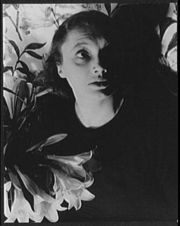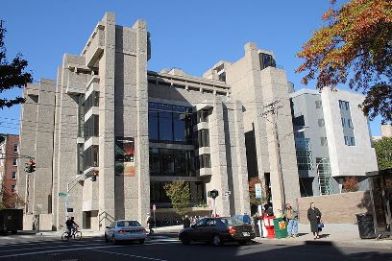History:
23 Beekman Place is rich with history, dating
back to the 1930s. The actress Katharine Cornell
(1893-1974) lived at 23 Beekman Place in the
1930s. Cornell was a talented stage actress,
writer, and theater owner and producer. She is
well known for her major Broadway roles in
serious dramas, often directed by her husband,
Guthrie McClintic. Her most famous role was as
English poet Elizabeth Barrett Browning in the
1931 Broadway production of “The Barretts of
Wimpole Street.” Katharine Cornell also won a
Tony Award for her role as Cleopatra in “Anthony
and Cleopatra” (1947).

Actress Katharine Cornell
In 1977, renowned modernist architect Paul Rudolph (1918-1997) designed the penthouse, adding four floors to the building. The penthouse served as Rudolph’s personal residence and design laborartory, where Rudolph experimented with materials and forms. The apartment explored spatial relationships with stairs, steel beams, and balconies. He created a multi-level apartment with as many as 17 levels. The apartment de-emphasized the walls as it focused on spatial relationships. The original Rudolph penthouse had transparent walkways, inspiring vertigo in some guests. Finally, Rudolph used reflective surfaces throughout his apartment, paying attention to issues of light. Rudolph was interested in light and shadow in his work. “Paul was fascinated with how lighting integral to a space could animate it and transform the whole psychological effect – he thought light was architecture’s fourth dimension,” said friend Ernst Wagner.

Architect Paul Rudolph
“For his own residence on Beekman Place in Manhattan, Rudolph created a mirror covered, steel-framed mix of balconies and stairs that has the look of a labyrinth and an intimate discotheque.” Ira Tattelman
Some of Rudolph’s original design elements remain intact in the penthouse today.
Paul Rudolph:
Paul Rudolph was born in Elkton, Kentucky in 1918. He was the son of Keener L. Rudolph, a Methodist minister and mother, Eurye Rudolph. He spent most of his youth in Alabama. He graduated from Alabama Polytechnic Institute in 1940. During World War II, Rudolph served as an officer in the US Naval Reserve, working on the design and construction of merchant ships. After the war, Rudolph studied at Harvard’s Graduate School of Design under Walter Gropious.
After completing his Master’s degree in Architecture in 1947, he entered a partnership with Ralph Twitchell in Florida. It was in Florida where Rudolph began to attract attention from the Architectural Community for his designs of private residences, many located in Sarasota. “He quickly established a reputation for designing modern, sophisticated vacation homes employing innovative design schemes and materials.” (Barnes). His work led him to receive commissions for larger projects including the Jewett Art Center at Wellesley College (1955).
From 1958 to 1965, Rudolph acted as Chairman of the Department of Architecture at Yale University. During this time period, Rudolph received commissions for important works including the Art and Architecture Building at Yale, the Government Services Center in Boston, and the SMTI/ UMass Dartmouth campus. Rudolph had developed a unique style of using ribbed, bush hammered concrete on the exterior surfaces. Inside, Rudolph created intricate multi-level spaces often playing with shadow and light. “Rudolph’s work is designed to excite and challenge its occupants.” (Tattelman).

Yale Art and Architecture Building, Paul Rudolph, 1963.
During the 1970s, Paul Rudolph’s career in the United States slowed considerably. However, in the late 1970s, Rudolph began to receive commissions for large scale projects in Asia. His notable works in Asia included the Lippo Centre, 1987, a landmark building in Hong Kong and the Wisma Dharmala Sakti building in Jakarta.
Paul Rudolph died August 8, 1997 in New York City from Mesothelioma, a cancer almost always caused by exposure to asbestos.
Paul Rudolph Quote:
“If an architect cares enough, and practices architecture as an art, then he must initiate design: he must create rather than make judgments.” Paul Rudolph
Bibliography:
Barnes, Bruce. “Paul Rudolph & his Architecture: Introduction.” 13 November 2008. <http://prudolph.lib.umassd.edu/introduction>
Tattelman, Ira. “Rudolph, Paul.” glbtq: An Encyclopedia of Gay, Lesbian, Bisexual,
Transgender, and Queer Culture. 10 December 2002. 13 November 2008. <http://www.glbtq.com/arts/rudolph_p.html>
Rudolph, Paul Marvin, 1918-1997. "Architecture and Society." Arca No. 62 (July/August 1992): 3-5.
Wikipedia. 2008. 13 November 2008. <http://en.wikipedia.org/wiki/Katharine_Cornell>
<http://en.wikipedia.org/wiki/Paul_Rudolph_(architect)>
The Beekman House
New York, New York 10022
Available for Photo Shoots, Video Shoots, and
Small Parties/Events up to 80 people maximum.
Copyright 2024, The Beekman House, Ruppert LLC, All rights reserved.